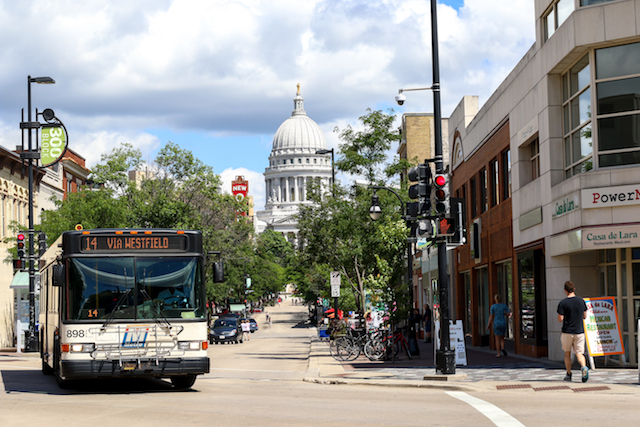At the downtown Senior Center in early May, the City of Madison had yet another in a series of public meetings on a hypothetical regional transportation system to compliment the local service provided by Madison Metro dating back to at least 2002. A video of the meeting can be seen here.

This time, the meeting focused on Bus Rapid Transit (BRT), not rail. BRT may be most suitable for an urban area our size, at least initially. The Madison area has become just too big to be served adequately by a local bus system alone, but it is not yet big enough to warrant having a more expensive rail system. BRT lines can be upgraded to higher-capacity rail if and when demand warrants.
However, the meeting left many residents questioning how well Madison’s transportation planners understood the complementary nature of local and rapid transit.
City staff spent much of the meeting talking about their plan for a 14.6 mile east-west starter BRT line. Based on a 2012-13 “corridor study” that looked at northern and southern routes in addition to the ones for the east, west and downtown, the latter ones were selected to start with because they were estimated to experience the highest ridership.
However, fulfilling the plan still depends both on 1) capital funding from a yet-to-be awarded federal grant and 2) dedicated funding from a currently-illegal Regional Transportation Authority. Once built, operating the starter line will cost an additional $3 million or so annually, funds that will come from Madison Metro's budget. Madison Metro would presumably in turn receive those additional funds from a hypothetically now-legal regional authority. Otherwise, funding would have to come from the already-inadequate amount now used for the current local bus system.
The Bus Rapid Transit (BRT) plan seems to understand this: “BRT routes will complement other Madison Metro transit services with faster and more efficient connections.” The problem is that the current plan is based on a corridor study that recommended the total elimination of major legs of then-current local bus lines, and we have not seen any repudiation of those recommendations.
For example, the study reads:
"Route 5 operates between the South and East Transfer Points. Weekday frequencies are 30-minutes during the day and 60-minutes in the evening. Weekend frequencies are 60-minutes all-day. It is proposed that the south portion of this route (between the South Transfer Point and downtown Madison) be eliminated and replaced with the BRT line." [bold added for emphasis]
The report then talks about another major local route:
"Route 6 operates from West Transfer Point through downtown Madison, to East Towne Mall, with alternating trips serving several different patterns. Existing weekday frequencies are 15 peak/30 midday and evening. Existing weekend frequencies are hourly. It is proposed the eastern portion of this route (east of downtown Madison) be eliminated, replaced with BRT service." [bold added for emphasis]
Madison Metro lines 22, 27 and 29 would receive similar treatment whereas many other lines would be "modified" but not have major legs amputated. (See Appendix I)
Since BRT stops much less frequently than local bus lines, nor would necessarily travel on the same street, BRT cannot simply "replace" a local bus. Rather, such analysis demonstrates a misunderstanding of the distinctive and complementary nature of rapid and local buses.
The report has sowed confusion and conflation among those who would otherwise know better since the author’s understanding of local buses was obviously quite limited. Is it a surprise therefore that many people seem unaware that the potential of local buses is underrated? After all, if consultants supposedly chosen for their expertise did not acknowledge the difference between BRT and local bus lines, why should anyone else?
A poor understanding of the potential for a good local bus system probably helps explain why the “Sustainable Madison Transportation Master Plan” (SMTMP) missed the opportunity to upgrade what existed. Better known as the “Madison in Motion” plan that came out in 2017 and is now the transportation element of Madison’s Comprehensive Plan, the initial intent of the SMTMP project back in 2012 was to upgrade our local bus system.
Madison Metro's system was attempting to maximize coverage for riders but in doing so had become so inconvenient that only a captive audience would ride many of the lines. The expectation was that a redesign could keep most of the bus stops on relevant routes while using straighter, more grid-like paths.
Using the same resources, the SMTMP did not, but could have, suggested the following:
1) Move bus lines in a more unidirectional fashion instead of meandering to maximize coverage;
2) Focus on higher frequencies on major corridors,
3) Use natural, not artificial, transfer points; and
4) Create core rapid-service corridors crossing the system, linking key destinations and transfer hubs.
Perhaps the experience of Anchorage, AK is most informative because of its similar size and harsh winters. A journalist covering their bus revamp of 2016-2017 reported that “on major roads, buses will be arriving much more frequently. Many routes are transforming into straight shots between two points for a faster trip instead of winding through neighborhood streets. Some buses will come every 15 minutes compared to an hour now on most runs…”
Increased frequency and rapidity on core routes did not necessitate BRT in Anchorage, rather a different design of the local system. But instead of making needed design changes in Madison too, Madison in Motion focused on designing new, and what will probably become segregated, Transit Oriented Developments at hypothetical Bus Rapid Transit stations. The nuance involved in recognizing the distinctive and complementary roles of rapid buses and an upgraded local transit service appears to have been lost.
Given the present political climate and uncertainty surrounding the acquisition of needed resources for establishing and operating a starter BRT line, it makes sense to consider an inferior way to have rapid buses as a starter "fall back" plan. Express buses that operate in regular traffic but stop less frequently than a regular bus could be a valuable way to expand service. Metro’s now retired head planner had actually posed this option over a decade ago, and Metro already runs a few such buses (routes 29, 56 and 57 for instance). It could run more, especially at peak times.
Indeed, to a user, a convenient ride is much more important than whether the bus stops at a BRT station or a regular Madison Metro bus stop.




